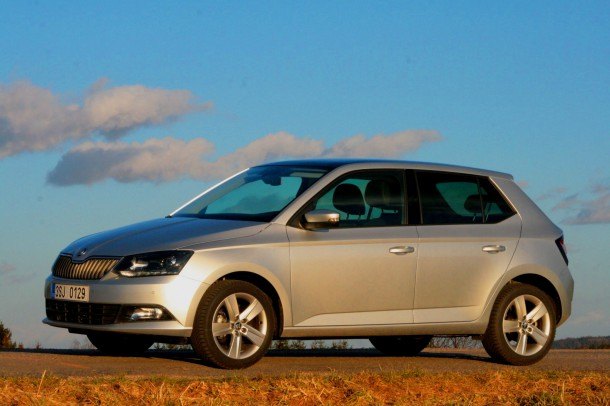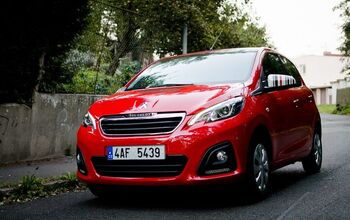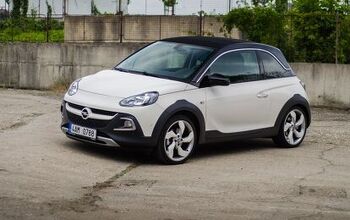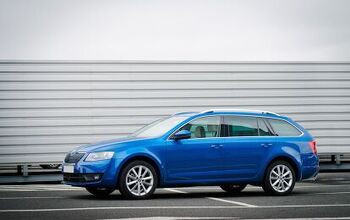2015 Koda Fabia European Review
Small cars used to be for the city. Now, they say a small car can work just like a big one. To find out what’s what, I borrowed a current Škoda Fabia, then took another new Fabia on a 400 mile trip.
I’m writing this in a hotel room balcony with a beautiful view of the Alps and Wörthersee lake, paid for by Škoda. The company wanted me to see the tuner culture at Wörthersee GTI Treffen (more about that in later article) and some of their concepts. To do that, they handed me the keys to a new Fabia, almost identical to a press tester I drove not even a month ago.
Both cars are fitted with the most powerful 110 hp 1.2 TSI engine in quite unlikely (at least for Czech market) “journo spec” with tons of options (price as tested around 400,000 CZK [MATH ERROR CORRECTED: $16,600 USD] including 22% VAT). The only important difference, save for colors, is the transmission. The one I drove at home for a week is equipped with a six-speed manual. On the trip to Austria I drove one with the seven-speed DSG automatic.
Both are very good. Hardly any Škoda made today is bad. But after yesterdays 7-hour drive, I think the automatic is the better option. I never thought I’d say that about a small car, but the DSG suits the Fabia’s character much more than the manual. The reasons for it are pretty much what defines the Fabia and sets it apart in its class.
To show what I mean, let me digress for a little bit. Last week, I drove a current Mazda2 in relative poverty spec (rare sight among journo cars) powered by the 75 hp Skyactiv 1.5 engine with a price of 311,000 CZK (approx. $13,000 USD, including 22% VAT). It was one of the most brilliant small cars I have ever driven. Yet, it couldn’t be any more different from Fabia.
The Mazda is playful and dynamic in its design, both inside and out. It’s immensely fun to drive with tail-happiness on throttle lift-off and an engine that’s just splendid, even in its least powerful form. I didn’t think it was possible these days to make a small, naturally aspirated engine that’s so rev happy, so pleasant to the ear and so joyous to use. But, the Mazda is also a bit cramped in the back thanks to a really small trunk and the doors make a tin sound when closed. Even if we discount for the cheap spec and slow engine, it just wouldn’t be the car you would want to take on a road trip. Alternatively, around town or on backroads, it’s wonderful. It was great on my 100 mile trip in the countryside. But a great car for long journeys it isn’t.
The Fabia is just the opposite. It’s design is not very playful. In a world of today’s aggressive cars, it’s not. It’s square. It looks like something Volvo could have made – if it was still in the business of making Volvos and wanted to make a small car. And it’s not different inside. The interior is clearly that of a Volkswagen product. Of course, the materials are cheap even when compared to the Polo, but the cold German style and precision is still there. It looks like a cheap, baby Audi. A nice place to be, but not very fun to look at.
It’s the same story with driving. The 1.2 TSI is one of the better examples of downsizing. With reasonable grunt at low revs making it feel like a much larger engine, and with great fuel economy (we did 5.8 l/100km on the way here, at fairly quick European highway speeds), it’s still not very fun companion. You can rev it, and it seems you have to rev it a little bit more than the old 1.2 TSI, but there’s no fun in it. And, at most speeds, there’s no point. It sounds nice, with a pleasant growl, but it won’t excite you like the Mazda. And while the shift action is nice, the car just feels better with the DSG automatic.
It’s the same with suspension. The Mazda is agile and surprisingly supple, but the Fabia is more stable, slightly better at smoothing out broken surfaces and feels much more “grown up”. With the manual, you can even find some fun hustling it around back roads – especially if you don’t drive small cars regularly and transferred to it from your full-size American sedan. But adjusting the line with throttle? Revving the engine just for the hell of it? Nah. It’s kid stuff. The Fabia doesn’t like that.
Where it works surprisingly well is on the highway. During the seven hours I spent behind the wheel, it felt right at home on both Czech and Austrian highways. And I felt right at home inside – the interior was roomy and nice enough for spending long periods of time, and my arse only started to get sore in the last 30 or so miles. After whole day, I got out of the car not really fresh, but not beaten up either.
In fact, the only thing that gave away I was driving a supermini and not a Golf of Focus sized car was the lack of power. Even with the most powerful engine available, the Fabia was quickly lost its oomph over 80 mph, and trying to keep up with two 170 hp 2.0 TDI Octavias required flooring it regularly with the DSG downshifting two or three cogs at a time. It can cruise at 110 mph, but even at 85 or 90, every time you brake due to other cars and get up to speed again, the Fabia feels strained. An American, used to large, powerful engines as standard on the other side of the pond, or a stranger to the idea of having to floor a car and rev it to the redline, would probably consider it unbearably slow with the 1.2 TSI.
But us Europeans are different and we even consider the lower powered variant of this engine to be acceptable for the much larger Octavias or Jettas.
The Verdict
The Fabia is a small car only in size, not in character. It’s not fun and lovable like a little puppy. It’s like the kid that’s all grown up, wants to wear grown up clothes, prefers talking to grown ups and hates playing kiddy games. It’s not very fun, and if you want your small car to behave like it, you won’t be satisfied. But if your reason for buying a small car is simply because you can’t afford a large one, and even if buying said small car is a sign of your status and what you’ve achieved in life, it’s exactly the car for you.
More by Vojta Dobe
Latest Car Reviews
Read moreLatest Product Reviews
Read moreRecent Comments
- Canam23 I had a 2014 GS350 that I bought with 30K miles and the certified unlimited four year warranty. After four and a half years I had 150K miles on it and sold it to Carmax when I moved to France a little over two years ago. As you can see I ran up a lot of work miles in that time and the Lexus was always quick, comfortable and solid, no issues at all. It was driving pretty much the same as new when I let it go and, and, this is why it's a Lexus, the interior still looked new. I bought it for 30K and sold it for 16K making it the most economical car I've ever owned. I really miss it, if you have to drive a lot, as I did in my job, it is the perfect car. Some may argue the Camry or Accord would foot that bill, but I say nay nay, you really want the comfort and rear wheel drive of the Lexus. Keep it forever Corey, you won't regret it.
- SCE to AUX "...if there’s enough demand"If they are only offered as electric to begin with, how will Stellantis gauge demand - unhappy customers demonstrating at the dealers with torches and pitchforks?What a great way to add cost and reduce competitiveness, by making a propulsion-agnostic platform with a hundred built-in compromises.
- FreedMike Awfully nice car.
- Cprescott So is this going to lie and tell you that they have quality products at affordable costs that won't get recalled?
- SCE to AUX So they might continue gigacasting 3 pieces instead of 1. Tesla does gigacasting as a business advantage, so they aren't abandoning it. They probably ran into some tech challenge related to integrating 3 pieces into 1, so 3 will do.Meanwhile Toyota and several Chinese mfrs are adopting gigacasting because of Tesla.











































Comments
Join the conversation
This Skoda looks more like an appliance than a vehicle to inspire. I do like the Skoda brand. The Yeti here in Australia has a cult following for the younger and Greener types. I shall describe them as alternates. Skoda could do much better if it could revise or better still replace that corporate grille they use. It's as fugly as it can get.
"...even if buying said small car is a sign of your status and what you’ve achieved in life..." "I pity the fool who try and show status with a small car." -America I thought Skoda was supposed to be the "value option" though, for brown shoes people who didn't care about showing off badge. Flash Europeans get one of those fancy VWs, or perhaps a Seat if they're feeling way sporty.